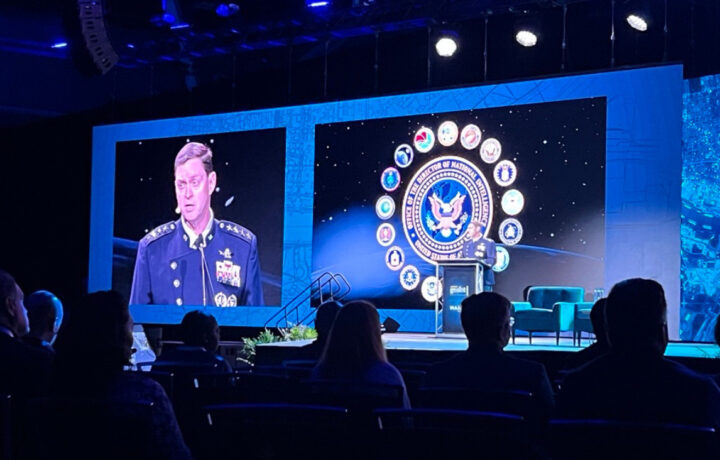At GEOINT 2025, General B. Chance Saltzman, Chief of Space Operations for the U.S. Space Force, delivered a powerful message about what it takes to achieve space superiority. And spoiler: it’s not more silos, more turf wars, or more tribalism. It’s about working together—across agencies, across missions, and across domains.
Standing alongside The Honorable Sue Gordon, former Principal Deputy Director of National Intelligence, Saltzman’s keynote and fireside chat doubled down on a theme that resonated throughout the week: collaboration isn’t optional. It’s mission-critical.
NGA + Space Force: A Long History, and a Bold Future
Saltzman kicked things off with praise for the National Geospatial-Intelligence Agency (NGA), calling it one of the Space Force’s most vital partners. He noted the historic ties between the agencies—even before they formally existed—and commended NGA’s legacy in St. Louis, Missouri, dating back to World War II.
With a newly signed Memorandum of Agreement (MOA) between Space Force and NGA Director VADM Frank Whitworth, Saltzman highlighted this as more than a formality. It’s a symbol of trust, unity, and momentum. And it’s a recognition that the stakes are too high—and the mission too big—for any single entity to go it alone.
“It doesn’t matter what your badge says. What matters is the mission,” Saltzman said.
Space Force’s Role: Speed, Breadth, and Superiority
Unlike NGA’s intelligence depth, Space Force is all about speed and breadth—ensuring our forces have freedom of action in the space domain, and denying that freedom to adversaries. That means clarity of roles matters: Space Force isn’t the Air Force’s space arm anymore. It’s its own military branch, with a very different job.
Saltzman emphasized that Space Force is not here to duplicate NGA or NRO efforts—but to complement them. Space Force is focused on responsiveness, resilience, and delivering on the tactical needs of warfighters.
The Pain (and Payoff) of Collaboration
In the fireside chat, Gordon pressed Saltzman on what makes collaboration with NGA so effective—and so hard. His answer? Assumptions. Legacy processes. Friction. And the sheer grind of figuring out how to “get into the business together.”
“Full-scale collaboration at every echelon,” Saltzman said. “You’ve got to sit side by side, hammer things out, and build that trust from the ground up.”
He noted that in a domain as dynamic as space, the urge to protect one’s turf—resources, authorities, budgets—is real. But he cautioned against it, reminding the audience that the space domain is already being used by adversaries, and the U.S. must be ready to engage. Space is not the future fight—it’s today’s fight.
Open Data, Resilience, and New Mission Demands
As the conversation moved to the future, Saltzman flagged several evolving dynamics:
- Transparency is growing. With unclassified data sets and even amateur astronomers contributing valuable information, the days of holding everything close are over.
- Resilience beats redundancy. In places like the Indo-Pacific, simply duplicating systems won’t cut it. Space architecture must be layered and survivable under attack.
- Growth—not reallocation—is the only path forward. The mission isn’t shifting old resources. It’s building something entirely new. “You can’t build the future with leftovers from the present,” Gordon added pointedly.
Teamwork Over Turf
Both Saltzman and Gordon repeatedly returned to the human element—the people doing the “backbreaking work” of forging partnerships, bridging gaps, and making collaboration real.
“We need more people carrying the space load—not fewer,” Saltzman said.
In other words: success in space doesn’t come from a single agency, a single capability, or a single concept. It comes from showing up as teammates.
Bonus Round: Myths, Milestones, and a Golden Vision
Before wrapping, Saltzman took a few moments to bust some common myths about the Space Force. No, it’s not about interplanetary defense—that’s NASA’s turf. UFOs? That’s the Navy. And Chinese balloons? That’s an Air Force matter. Space Force, he reminded the room, has its own focused and essential mission: space superiority, not sci-fi headlines.
Saltzman also celebrated the promotion of Gen. Michael A. Guetlein to Vice Chief of Space Operations, offering both congratulations and condolences for the complexity ahead. “There’s no better person for that job,” he said. “But he’s going to have to stitch together a system of systems. That’s not easy.”
In a nod to the venue itself, Gordon asked how the grand “Golden Dome” room—where the keynote took place—supports the mission of space. Saltzman was clear: sometimes, you need a space like this to inspire. And when it comes to attracting top talent and reinforcing national security culture, the setting can be the spark.
“A challenge is what drives the military,” Saltzman concluded. “And this mission, in this domain, is full of them.”




